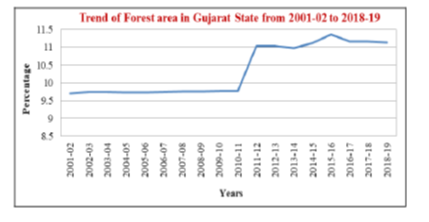
Geographical analysis
Department of Geography & GIS

Department of Geography & GIS

Geographical analysis
Year: 2020, Volume: 9, Issue: 2, Pages: 42-50
Original Article
Holly Dehingia1, P Surendra2
1M.Sc. Student, Department of Geography, Bangalore University, Bengaluru, India
2Assistant Professor, Department of Geography, Bangalore University, Bengaluru, India
Received Date:22 September 2020, Accepted Date:15 November 2020
In this paper an attempt has been made to analyse the Spatio-temporal changes of forest area in Gujarat state. This study is based on secondary data collected from the Gujarat forest department and forest survey of India for the period of 2001-02 to 2018-19. The trends in forest area of Gujarat state from 2001-02 with 9.7% and in the year 2018-19, thus making the forest area 11.4% of the total geographical area. The forest area under reserved forest 75.3%, protected forest 2.0% and unclassed forest 23.7% of Gujarat during the period of 2001-02 and 2018-19 reserved forest 66.7%, protected forest 13.3% and unclassed forest 20.1%. The study covers 33 districts of Gujarat state which come under the variation in spatio-temporal changes in the forest area of different divisions during the period of 2001-02, 2010-11 and 2018-19.
Keywords: Forest area; temporal changes
Adam, Gumilar., Hermawan, Rachmad., and Prasetyo, Lilik Budi.2017, “Use of Geographical Information System (GIS) and Remote Sensing in Development of Urban Forest Types and Shapes in Tangerang Selatan City”, Earth and Environmental Science, Volume 54, doi:10.1088/1755-1315/54/1/012051.
Bagra, Kenjum., Chaudhry,Pradeep., and Singh, Bilas.2011, “Urban Greenery Status of Some Indian Cities”, International Journal of Environmental Science and Development, Volume 2, Number 2.
Bhalla, Priya, Bhattacharyaand Prodyut.2015, “Urban Biodiversity and Green Spaces in Delhi: A Case Study of New Settlement and Lutyen’s Delhi”, The Journal of Human Ecology, 51(1,2), 83-96,2015.
Chaudhry, Pradeep., and Tewari, Vindhya P.2011, “Urban Forestry in India: Development and Research Scenario”, Interdisciplinary Environmental Review, volume 12, number 1, 2011.
Dobbs, C., Eleuterio, A.A., Amaya, J.D., Montoya, J., and Kendal, D.2018, “The Benefits of Urban and Peri-Urban Forestry”, Unasylva 250, Volume 69, 2018/1.
Dwivedi, Puneet., Rathore, Chinmaya S., and Dubey, Yogesh.2009, “Ecological Benefits of Urban Forestry: The Case of Kerwa Forest Area (KFA), Bhopal, India”, Applied Geography, 29,194-200.
Endreny, Theodore A.2018, “Strategically Growing the Urban Forest Will Improve Our World”, Nature Communications, volume 9, doi: 10.1038/s41467-018-03622-0.
Fuwape, Joseph A., Onyekwelu and Jonathan C.2010, “Urban Forest Development in West Africa: Benefits and Challenges”, Journal of Biodiversity and Ecological Sciences, Volume 1, Issue 1.
Gujarat Forest Statistics.2001-02, “Area Classification”, 11-22.
Gujarat Forest Statistics.2010-11, “Area Classification”, 12-23.
Gujarta Forest Statistics.2018-19, “Area Classification”, 15-28.
India State of Forest Report. 2011, “Forest and Tree Resources in States and Union Territories”, 127-132
Kuo and Frances E. 2003, “Social Aspects of Urban Forestry, the Role of Arboriculture in a Healthy Social Ecology”, Journal of Arboriculture, Volume 29, Number 3
Pearlmutter, D., Carinanos, P., Calaza, P., Hiemstra, J., and Vilgar, U.2018, “The Role of Urban and Peri-Urban Forests in Reducing Risks and Managing Disasters”, Unasylva 250, Volume 69, 2018/1.
Saha, Tarun. 2017, “Urban Forestry: Strategy and Planning I Indian Context”, International Journal of Humanities and Social Science Studies, volume-4, Issue-1.
Salbitano, Fabio., Borelli, Simone., Conigliaro, Michela., and Chen, Yujuan.2016, “Guidelines On Urban And Peri Urban Forestry”, Food And Agriculture OrganizationsOf The United Nations, FAO Forestry Paper-178.
Tasoulas, Evangelos., Varras, Gregory., Tsirogiannis, Ioanninnis.,and Myriounis, Christos.2013, “Development of A GIS Application for Urban Forestry Management Planning”, Procedia Technology, volume 8, 70-80.
Tripathi, Mayank., and Joshi, Hema.2015, “Carbon Flow in Delhi Urban Forest Ecosystem”, Annals of Biological Research, volume 6, Number 8, 13-17.
© 2020 Dehingia & Surendra. This is an open-access article distributed under the terms of the Creative Commons Attribution License, which permits unrestricted use, distribution, and reproduction in any medium, provided the original author and source are credited.
Published By Bangalore University, Bengaluru, Karnataka
Subscribe now for latest articles and news.